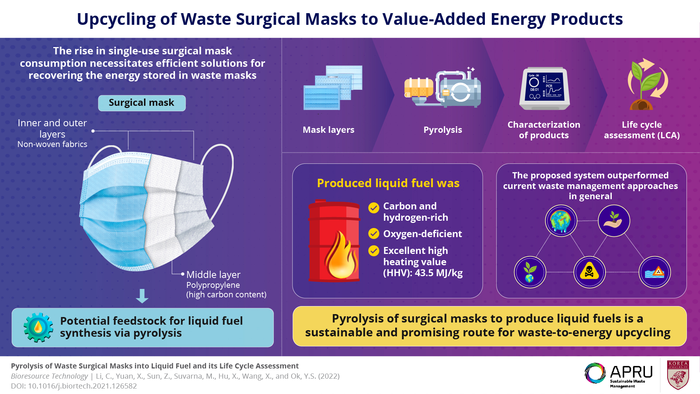Surgical masks are being used in almost every country around the world as the first barrier against COVID-19.
 Since the COVID-19 pandemic started, single-use polyethylene surgical masks are discarded by the millions every single day. This study proposes a sustainable method to convert this waste into a value-added product — liquid fuel — through pyrolysis. Image Credit: Professor Yong Sik Ok from Korea University, Seoul, Korea.
Since the COVID-19 pandemic started, single-use polyethylene surgical masks are discarded by the millions every single day. This study proposes a sustainable method to convert this waste into a value-added product — liquid fuel — through pyrolysis. Image Credit: Professor Yong Sik Ok from Korea University, Seoul, Korea.
Soon after the pandemic began, the demand for disposable masks increased rapidly to extraordinary levels; by June 2020, China alone was producing approximately 200 million masks per day.
But the massive amount of bulk waste created by these masks — paired with staff scarcities in waste management systems because of the pandemic — significantly worsened the threat that these plastic products pose to human health as well as the environment.
However, disposed masks can be converted into something beneficial to keep them away from landfills, incinerators, soils and oceans. This has been demonstrated by a team of scientists in a new study published in Bioresource Technology, who examined the potential of turning surgical masks into value-added chemicals through a thermal decomposition process known as “pyrolysis.”
This international team of researchers was guided by Professor Yong Sik Ok and Dr. Xiangzhou Yuan of Korea University, South Korea, who received huge support from Professor Xun Hu of the University of Jinan and Professor Xiaonan Wang of the National University of Singapore and Tsinghua University.
While the pyrolysis of polypropylene — the key constituent of surgical masks — has already been explored in-depth, masks typically contain other fillers that could influence their pyrolysis behavior. Thus, the researchers had to prudently examine how the pyrolysis conditions influenced the obtained products, which came in liquid, gaseous and solid forms.
For that reason, they performed many experiments at varying pyrolysis temperatures and with varying heating rates, recording all the outputs and putting them through detailed characterization.
Specifically, one set of pyrolysis conditions produced a carbon-rich and oxygen-deficient liquid oil as the primary product. Additional analyses showed that this oil had a high heating value of 43.5 MJ/kg, which is only marginally lower than that of gasoline and diesel fuel.
In other words, the findings demonstrated that surgical masks can be turned into a burnable fuel that can consecutively be used, for example, to produce electricity.
The theory does not end there; however, being able to turn waste into something beneficial does not essentially make it a good idea. It is imperative to first evaluate the combined environmental effect of all the processes involved and compare it with that of existing practices before thinking of executing them.
Therefore, the team carried out a life-cycle assessment (LCA) of their methodology to properly understand its advantages and disadvantages. The LCA is a method that is extensively used to measure the environmental impacts related to the whole life cycle of a product; in this case, the cast-off masks marked the start of the cycle while the electricity produced using the obtained fuel marked its end.
The outcomes of the LCA were encouraging, representing that the conversion of waste masks into electricity via pyrolysis provided better performance than most conventional waste management methods on numerous fronts, including less CO2 emissions, less phosphorous emissions and less terrestrial ecotoxicity.
We verified that upcycling post-consumer surgical masks into value-added energy products represents a sustainable and promising route with notable environmental benefits.
Dr. Xiangzhou Yuan, Study Lead and Professor, Korea University
On the whole, the findings of this research specify that pyrolysis is an appealing option to solve the issues posed by discarded surgical waste masks, ensuring sustainable waste management, while producing energy and decreasing the environmental impact.
Understanding new ways to turn surgical masks into value-added energy products will help us mitigate plastic pollution and achieve sustainable waste-to-energy conversion in the future. The novel upcycling route proposed in our study could help us protect Earth’s ecosystems and reach several of the United Nation’s sustainable development goals.
Yong Sik Ok, Study Lead and Professor, Korea University
The researchers hope this idea will be further tested and eventually executed so that the environment is preserved.
Journal Reference:
Li, C., et al. (2022) Pyrolysis of waste surgical masks into liquid fuel and its life-cycle assessment. Bioresource Technology. doi.org/10.1016/j.biortech.2021.126582.